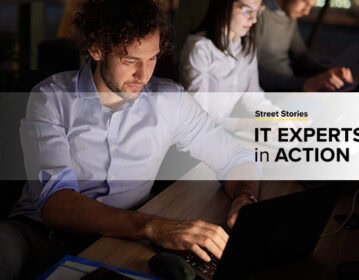
In my many years as a CIO in the retail industry before joining Rimini Street, I’ve seen firsthand how the roles of CIOs and CFOs have become increasingly intertwined. Traditionally, IT strategy and investment were largely the CIO’s domain, but today, CFOs play an equally significant role. “C-Suite Imperatives: Evolving IT and Enterprise Investments,” Rimini Street’s survey of nearly 3,000 CIOs and CFOs globally highlighted this shift, with both groups believing they drive technology investment decisions. This split reinforces the importance of collaboration. I recently had the opportunity to share my thoughts on this and what CIOs should focus on in 2025 with my colleague, the GVP of Industry Solutions at Rimini Street. Watch the full conversation below or read on for highlights and takeaways.
As a CIO in retail, I worked closely with my CFO to align priorities. It wasn’t about whose perspective was “right” – it was about bridging the gap between technology and business to create a unified strategy. This collaboration often resulted in passionate discussions, but ultimately, helped us develop a clear, aligned roadmap that guided our decisions for the year ahead.
Finding room for innovation with tight budgets
Though budget and resource constraints are a constant challenge for CIOs, I’ve learned that innovation doesn’t have to take a back seat. For me, the key was identifying areas where we could optimize costs and reinvesting those savings into transformative projects.
One approach I used was categorizing our IT budget into “Run,” “Grow,” “Optimize,” and “Protect.” By focusing on reducing the “Run” category, which often consumes 80-90% of retail IT budgets, we freed up resources for growth and optimization. It’s one of the many ways that Rimini Street helps companies drive innovation. In past roles, I’ve used Rimini Street to significantly reduce maintenance costs. In one example, we used those savings to invest in omnichannel capabilities to optimize inventory across stores to reduce costly markdowns. That decision didn’t just save money – it drove real returns for the business.
Emerging IT trends in retail
Looking ahead, there are several key IT trends I believe CIOs should prioritize this year. Two that stand out to me: omnichannel customer experiences and AI.
In retail, the ability to seamlessly connect online, offline, and hybrid customer journeys is more important than ever. Customers demand personalized and cohesive experiences, and companies that can deliver on this expectation will gain a competitive edge.
AI is another area that’s truly transforming industries. During my conversation with Emmanuelle, I shared examples of how leading companies are leveraging AI:
- Personalization: Brands like Nike use AI to offer customized product designs, strengthening customer loyalty.
- Automation: Grocery stores like Aldi have implemented AI-driven cashier-less checkout systems, revolutionizing the shopping experience.
AI isn’t just about improving the customer experience – it’s also about optimizing operations. For example, Walmart uses AI for real-time inventory management, reducing waste and ensuring products are always available.
That said, adopting AI requires a strong technical foundation. I often advocate for a “composable ERP” approach, where organizations add fit-for-purpose solutions around their core systems. This strategy enables businesses to achieve meaningful improvements without the disruption and cost of major system overhauls.
My advice for retail CIOs in 2025
As you plan for success this year, my advice to fellow CIOs is simple:
- Be an innovator: CIOs must embrace their role as change agents and foster strong partnerships with CFOs to align IT and business goals.
- Prioritize and fund transformation: Innovation can’t happen without funding. Reallocate resources strategically to drive growth and optimization.
- Leverage AI: If your organization hasn’t started incorporating AI into your strategy, you’re already behind. AI has the potential to solve key challenges and unlock tremendous value.
Standing still is not an option. Technology investments must be strategic, collaborative, and transparent. I’m a firm believer that with the right approach, CIOs can not only meet but exceed their organizations’ expectations, driving both growth and profitability. At Rimini Street, I’ve seen how organizations can achieve these goals, and I’m excited to continue helping companies navigate the challenges and opportunities ahead. For more insights and examples, watch the full conversation now.
Learn more about how we support retailers and browse success stories from some of our retail clients.
Key Takeaway: In 2025, retail CIOs should focus on collaborating more closely with their CFOs to align business and technology goals and find ways to optimize resources to invest in AI to drive personalization and automation to gain a competitive advantage. Learn how Rimini Street helps CIOs in retail reduce costs and invest in innovation.
FAQs:
Q: What should retail CIOs focus on in 2025?
A: In 2025, CIOs should focus on:
- Being an innovator: CIOs must embrace their role as change agents and foster strong partnerships with CFOs to align IT and business goals.
- Prioritizing and fund transformation: Innovation can’t happen without funding. Reallocate resources strategically to drive growth and optimization.
- Leveraging AI: If your organization hasn’t started incorporating AI into your strategy, you’re already behind. AI has the potential to solve key challenges and unlock tremendous value.
Q: What are emerging trends retail CIOs should focus on?
A: Emerging trends in retail IT are:
- Personalization: Brands like Nike use AI to offer customized product designs, strengthening customer loyalty.
- Automation: Grocery stores like Aldi have implemented AI-driven cashier-less checkout systems, revolutionizing the shopping experience.







